I am looking to build a set of electro stats and work at a stamping shop so I will be making the stators myself. My concern is that it'll take some work to make the panels straight if I punch them out, so does the rounded edge from punching have to be there, or would I get similar/equal output if I laser the holes into the sheet instead?
I do plan to make small (6x6 inch) test panels before the full size (18x48) ones, and I plan to toy around with curved panels but will do flat first. These panels will all be powder coated by a local guy that's got all the equipment. So any other information on recommended hole size and pattern would be great. All I really know is I want maximum open area (was going to try for ~50%).
I do plan to make small (6x6 inch) test panels before the full size (18x48) ones, and I plan to toy around with curved panels but will do flat first. These panels will all be powder coated by a local guy that's got all the equipment. So any other information on recommended hole size and pattern would be great. All I really know is I want maximum open area (was going to try for ~50%).
You want the rounded side to the inside or should remove the bur witch is hard I think. I think laser leaves crap to just like plasma ? Or is it exactly clean ? I thought water yet is completely free of crap but I gues is not really an option
About coating ask Gerald he's did some test panels about coating 🙂
About coating ask Gerald he's did some test panels about coating 🙂
If you can punch itself why not buy pcb board and punch it , don't know what sizes you are able to punch. But isolation would be far more simple that way
Well the laser slag was a problem the shop had to tackle once so we have a solution to that, and either way i go i can do hole sizes from 0.030" to 1.75". My main reason for asking is, based on my undestanding of fluid mechanics, there could be a difference in the way the fluid (air) flows through the panel (see here https://neutrium.net/fluid_flow/pressure-loss-from-pipe-entrances-and-exits/ ). I know for sure having the rounded entrance is better numerically, but would the straight cut of a laser be even a measurable difference or am i counting grains of sand in a desert?
it is all not taht big of a deal , its more that the slag or with punching the rough side could be a problem with isolating the stators since flash overs tend to start at sharp points, also ozone witch could cripple the isolating coating . another reason why rounded would be better is coating a sharp edge is hard you dont get a decent buildup there, best way is fluidized powder coating btw
sound wise that tiny bit of roughnes on one side on a punched panels is no big deal. trow it in acid if you want to have it rounded or removed 🙂
openness of around 40%-50 is the general rule of thumb as far as i know. many smaller holes are better then fewer big ones.
sound wise that tiny bit of roughnes on one side on a punched panels is no big deal. trow it in acid if you want to have it rounded or removed 🙂
openness of around 40%-50 is the general rule of thumb as far as i know. many smaller holes are better then fewer big ones.
Last edited:
When you select your hole size you also have to consider the build up thickness of your coating .030" dia. is definitly way to small in that manner.
Typically 5/64" to 1/4 has been used by most as that is what is available.
Powder coating can give you a nice base to start with, But getting a consistant coating that doesn't have any micro cracks can be a bit of a challenge.
I had this problem when I had my window screen stators Powder coat, then about 7 years later they started to develop cracks and chips.
I was able to reseal them with some clear acyrlic spray paint.
Also getting your coater to get a thick enough coating may be an issue as well not to mention double and triple coating them.
My coater could only do a doulbe coat for me and refused to do a triple coat for what ever reason.
Powder coating worked great if it is done right the first time but if it is not, experimentation can be costly and very time consuming.
Your best bet is to use the porpe paint trcks I have outlined in another thread.
As WrineX has pointed out sharp edges are your worst enemy, just one sharp edge on my Experimental PC stator was the cause of there final demise of being badly burned.
Once this happens it is nearly impossible to repair them and hold back the voltages needed to get great high performance out of an ESL.
Transformer voltages can swing as high as +/- 10KV or more and with a bias of up to 7Kv or so.
I was one able to get as high as 25Kv Peak to Peak but I had never reached that again after the First Time they failed!!
I got tired of trying to fix them using more coats of clear acyrlic and sealling the bad spots with clear finger nail polish with teflon, SO I just let them burn for the last time and decided to make a new set that could handle the voltages.
Perforated metal is costly compared to other materails I have used although it is prefered by many, I can't imagine trying to punch out a panel myself though.
My materails of choice are still plain ole' window screen or use ing TIG rod to build stators.
They are by far the cheapest to work with.
I have seen many excellent results here using PCB materail as well, Providing that it is properly coated using common off the shelf spary paints.
Do plan on trying PC coating some window screen again sometime once I build a fluidizing vat for my small panel design.
Here is the thread we did on coatings and this post is where I had shown my results, the whole thread is worth readin for the beginning though,
http://www.diyaudio.com/forums/plan...tric-coatings-fact-fiction-2.html#post2893839
I was able to get great results considering my quite small hole size and my open area was estimated to be about 35%-38% for my first painted models or so, but a bit higher to about 45% if I recall with the PC coated ones.
I liked the sound of the PC ones due to that they had increased open area, but both models were incredible do to the nature of ESL's .
Folowing the advice I gave in the thread that I posted, I was able to get a very high performace coating that rivaled my PC coated stators and was much easier to construct.
I have been planning a thread to build a new improved model of my original design when time permits.
And I have already built one using TIG rod as well.
If you are looking to build a Full range setup you may want to consider a electrically segmented design using TIG rod.
CharlieM and one other DIYer ( I forget the name at this time) has built such a panel using TIG rod and likes it much better than his original perforated metal panels.
Jazzman's DIY Electrostatic Loudspeaker Page
It would be much cheaper to make than trying punch your own panels.
http://www.diyaudio.com/forums/planars-exotics/267694-thinking-about-segmented-wire-stator-esl.html
Small panels require high operating voltages to get decent impressive results, this is due to their small surface area compared to a larger panel.
Once I had figured this out I still love building small panels with very impressive results and not to mention they are easier to handle and cheaper to build.
I just Picked up Mavric's panels about 7 weeks ago and when I get them set up it will be my first ever experience with larger panels.
The build thread on those can be found here,
http://www.diyaudio.com/forums/planars-exotics/162127-different-ideas-esl-panels.html#post2099310
And here,
http://www.diyaudio.com/forums/planars-exotics/158115-material-esl.html#post2037964
Maybe those will help you to get some ideas as well.
jer 🙂
P.S. Pictures are of 14KV arc coating tests and my original panels and the FR graph of them.
Typically 5/64" to 1/4 has been used by most as that is what is available.
Powder coating can give you a nice base to start with, But getting a consistant coating that doesn't have any micro cracks can be a bit of a challenge.
I had this problem when I had my window screen stators Powder coat, then about 7 years later they started to develop cracks and chips.
I was able to reseal them with some clear acyrlic spray paint.
Also getting your coater to get a thick enough coating may be an issue as well not to mention double and triple coating them.
My coater could only do a doulbe coat for me and refused to do a triple coat for what ever reason.
Powder coating worked great if it is done right the first time but if it is not, experimentation can be costly and very time consuming.
Your best bet is to use the porpe paint trcks I have outlined in another thread.
As WrineX has pointed out sharp edges are your worst enemy, just one sharp edge on my Experimental PC stator was the cause of there final demise of being badly burned.
Once this happens it is nearly impossible to repair them and hold back the voltages needed to get great high performance out of an ESL.
Transformer voltages can swing as high as +/- 10KV or more and with a bias of up to 7Kv or so.
I was one able to get as high as 25Kv Peak to Peak but I had never reached that again after the First Time they failed!!
I got tired of trying to fix them using more coats of clear acyrlic and sealling the bad spots with clear finger nail polish with teflon, SO I just let them burn for the last time and decided to make a new set that could handle the voltages.
Perforated metal is costly compared to other materails I have used although it is prefered by many, I can't imagine trying to punch out a panel myself though.
My materails of choice are still plain ole' window screen or use ing TIG rod to build stators.
They are by far the cheapest to work with.
I have seen many excellent results here using PCB materail as well, Providing that it is properly coated using common off the shelf spary paints.
Do plan on trying PC coating some window screen again sometime once I build a fluidizing vat for my small panel design.
Here is the thread we did on coatings and this post is where I had shown my results, the whole thread is worth readin for the beginning though,
http://www.diyaudio.com/forums/plan...tric-coatings-fact-fiction-2.html#post2893839
I was able to get great results considering my quite small hole size and my open area was estimated to be about 35%-38% for my first painted models or so, but a bit higher to about 45% if I recall with the PC coated ones.
I liked the sound of the PC ones due to that they had increased open area, but both models were incredible do to the nature of ESL's .
Folowing the advice I gave in the thread that I posted, I was able to get a very high performace coating that rivaled my PC coated stators and was much easier to construct.
I have been planning a thread to build a new improved model of my original design when time permits.
And I have already built one using TIG rod as well.
If you are looking to build a Full range setup you may want to consider a electrically segmented design using TIG rod.
CharlieM and one other DIYer ( I forget the name at this time) has built such a panel using TIG rod and likes it much better than his original perforated metal panels.
Jazzman's DIY Electrostatic Loudspeaker Page
It would be much cheaper to make than trying punch your own panels.
http://www.diyaudio.com/forums/planars-exotics/267694-thinking-about-segmented-wire-stator-esl.html
Small panels require high operating voltages to get decent impressive results, this is due to their small surface area compared to a larger panel.
Once I had figured this out I still love building small panels with very impressive results and not to mention they are easier to handle and cheaper to build.
I just Picked up Mavric's panels about 7 weeks ago and when I get them set up it will be my first ever experience with larger panels.
The build thread on those can be found here,
http://www.diyaudio.com/forums/planars-exotics/162127-different-ideas-esl-panels.html#post2099310
And here,
http://www.diyaudio.com/forums/planars-exotics/158115-material-esl.html#post2037964
Maybe those will help you to get some ideas as well.
jer 🙂
P.S. Pictures are of 14KV arc coating tests and my original panels and the FR graph of them.
Attachments
-
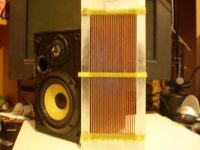 ESL2.jpg60.4 KB · Views: 131
ESL2.jpg60.4 KB · Views: 131 -
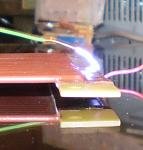 Arcing Around the Coating But Not Through It.jpg5 KB · Views: 150
Arcing Around the Coating But Not Through It.jpg5 KB · Views: 150 -
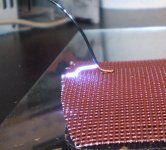 14Kv closeup.jpg143.2 KB · Views: 140
14Kv closeup.jpg143.2 KB · Views: 140 -
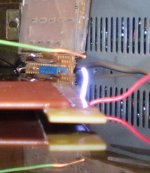 A Rare Shot Of The Arc Attracted to the Positive Ground wire.jpg127.5 KB · Views: 145
A Rare Shot Of The Arc Attracted to the Positive Ground wire.jpg127.5 KB · Views: 145 -
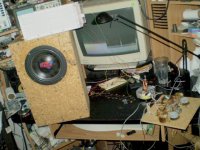 S1.jpg76 KB · Views: 137
S1.jpg76 KB · Views: 137 -
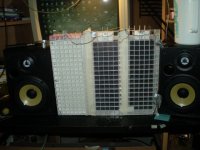 three panel setup.jpg55.7 KB · Views: 143
three panel setup.jpg55.7 KB · Views: 143 -
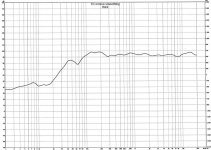 Third Smoothing.jpg126.1 KB · Views: 76
Third Smoothing.jpg126.1 KB · Views: 76
Last edited:
thanks for the tips and links i will be sure to give it a read. Left the idea alone till now as i finally have enough for the bias.
- Status
- Not open for further replies.
- Home
- Loudspeakers
- Planars & Exotics
- Electro stats, stator requirements